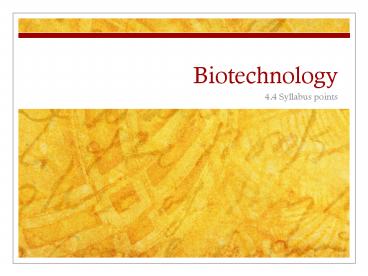Biotechnology - PowerPoint PPT Presentation
1 / 22
Title:
Biotechnology
Description:
Biotechnology 4.4 Syllabus points ... beta carotene into rice prevent blindness Salt resistant tomatoes Proponents will help solve world hunger Critics ... – PowerPoint PPT presentation
Number of Views:49
Avg rating:3.0/5.0
Title: Biotechnology
1
Biotechnology
- 4.4 Syllabus points
2
4.4.1 PCR
- Outline use of PCR to copy and amplify minute
quantities of DNA - PCR polymerase chain reaction
- Helps to get enough DNA to analyze when a sample
is very small - Thermocycler - machine automates the copying of
the DNA - Millions of copies in a few hours
3
PCR
- Uses DNA polymerase from bacteria that lives in
hot springs Thermus aquaticus - 3 steps
- Denature heat up breaks double into single
strand (about 98 degrees C) - Anneal cool and primers can attach to either a
top or bottom strand - Extension Taq polymerase makes complementary
strand
4
PCR
- Repeated cycles of heating and cooling stimulates
the primers to attach to copies and copies of
copies - Result is exponential increase in number of
copies of DNA
5
4.4.2
- Gel electrophoresis separates DNA by size as move
in electric field - DNA negative charge move towards positive pole
- Agarose gel forms mesh of cross linked polymers
- DNA stained to visualize the separated bands
6
4.4.3
- Gel electrophoresis of DNA used in DNA profiling
- Matching an unknown sample with a known to see if
they match up is DNA profiling - Identical band patterns means that is the
individual in question similar patterns usually
mean the individuals are relatives
7
4.4.4 Applications of DNA profiling
- Paternity legal identification of biological
father - Forensic investigations compare samples from
crime scene with suspect - Cold cases reopen with new DNA technology such as
PCR - Release of wrongly imprisoned individuals
8
4.4.5 Analyze gels
- Use gel banding patterns to determine matches
between individuals to solve crimes or determine
paternity
9
4.4.6 Human Genome Project
- Outline three outcomes of sequencing the complete
human genome - 1990-2003 international effort
- Government and private labs
- Aimed to identify the entire sequence of bases in
human DNA - Created in essence a map of all genes on all 23
chromosomes
10
4.4.6 Human genome
- Allows identification of location of genes
causing diseases - Production of new medications by identifying
products made by healthy individuals determine
the gene responsible copy the gene and use it to
produce the desired molecule - Evolutionary relationships and migration patterns
of humans
11
4.4.7 Gene transfer
- Genes can be transferred between species because
DNA is universal language and code for the same
amino acids - So gene will produce the same protein no matter
what organism it is placed into
12
Examples gene transfer
- Cold resistant tomatoes
- Bt-corn (Bacillus thuringiensis)
- Spider silk goats
13
4.4.8 Technique Gene Transfer
- Cut and paste genes using restriction enzymes AKA
endonucleases find and cut at target sequences - Paste genes using DNA ligase enzyme which
recognizes the sticky ends of the fragments and
attaches them
14
Copy paste using plasmid DNA
- Use host cell often Escherichia coli or yeast
- Prokaryotes most DNA in single chromosome but
also have extra DNA is small loops called
plasmids - To copy DNA it needs to be pasted into a plasmid
15
4.4.8 Pasting into plasmid
- Remove plasmid from cytoplasm of bacteria
- Cut open plasmid using restriction enzyme
- Paste new gene using DNA ligase into the open
plasmid - Modified plasmid called a recombinant plasmid
- Recombinant plasmid used to deliver new gene into
genome of target organism
16
4.4.9 Genetically Modified organisms
- Golden rice beta carotene into rice prevent
blindness - Salt resistant tomatoes
- Proponents will help solve world hunger
- Critics world hunger is distribution not
production issue
17
4.4.10 Benefits/Risks GMO
- Benefits
- Improve food production
- Reduce chemicals if plants have own pest control
substances - Reduce cost and pollution of making medicines
- Farmers have added control of crops and livestock
- Globally GM crops need less water and pesticides
18
4.4.10 Risks
- Risks- long term risks unknown
- Pollen escapes into wild integrated possibly into
wild genome - Genes could cross species seen in labs could it
happen in wild? - Bt crops harmful to humans pesticide throughout
plant not just on surface - Allergies
- Large corporations will own large part of food
supply - High tech not always better than simple solutions
- Decrease in biodiversity
19
4.4.11 Cloning
- Define clone
- Group of identically identical organisms or group
of cells artificially derived from a single
parent - Farmers have cloned plants for years by
regenerating plant material
20
4.4.12 Technique cloning
- Enucleate unfertilized egg and transfer nuclear
material from donor cell - Electrical current fuses egg and nucleus
- Zygote divides and forms embryo which is
implanted in surrogate mother - Donor cell may be adult differentiated cell (non
gamete) rather than from an egg cell - Offspring is clone of donor organism
21
4.4.13 Ethics therapeutic cloning
- Cloning using undifferentiated cells
- AKA embryonic stem cells
- Requires production of human embryos
- Is it ethical to generate new humans for medical
research? - However, stem cells allow repair of burns, new
heart muscle, new kidney tissue
22
Types of Cloning
- Therapeutic cloning makes new tissues
- Reproductive cloning makes new organisms

